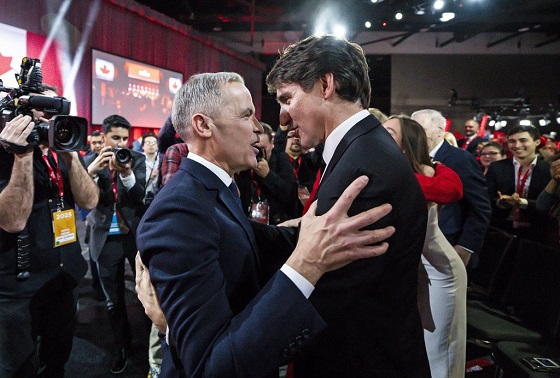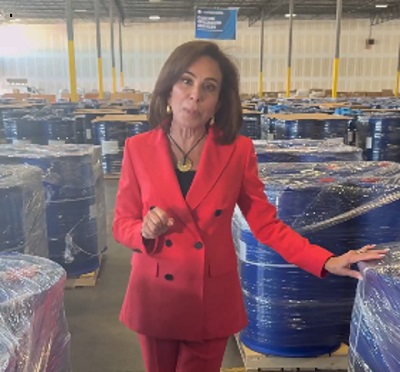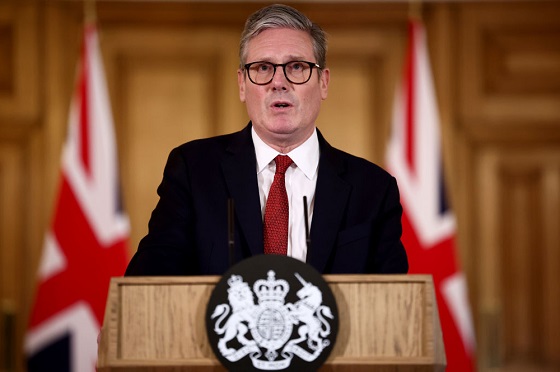Business
Ontario leaders back East–West corridor linking Alberta energy across the country

Matthew Slotwinski, CEO of the Sarnia-Lambton Economic Partnership. Photo courtesy SLEP
From the Canadian Energy Centre
‘The sooner this gets done, the better’
From his desk in Marathon, Ont., a small community on the north shore of Lake Superior, Mayor Rick Dumas sees the concept of an energy corridor to Western Canada’s oil and gas as a chance to reshape his region’s future.
The Ontario government issued a request for proposals on August 7 for a feasibility study into the idea, which would move energy products from across the Prairies and Northern Ontario to consumers and exporters in the East.
“Projects like the East-West Energy Corridor are exactly what Northwestern Ontario has been calling for — an opportunity to be at the forefront of a nation-building initiative,” said Dumas, who is also president of the Northwestern Ontario Municipal Association, representing the districts of Kenora, Rainy River and Thunder Bay.
“It means new jobs, greater economic opportunity, and a real commitment to building a cleaner, stronger, and more resilient country together.”
The feasibility study will map potential pipeline routes linking Alberta to Southern Ontario’s refining sector and new tidewater ports, including on James Bay, Hudson Bay and the Great Lakes.
It will also assess the construction or expansion of a refinery, examine Indigenous equity opportunities, and even explore the creation of a Canadian strategic petroleum reserve.
Support for the corridor also comes from Southern Ontario, where the region’s petrochemical and energy industries depend on oil and gas supplies delivered by a pipeline that crosses Michigan.
“We believe this represents an opportunity to achieve both energy security for Ontario and Canada, and economic growth and diversification potential,” said Matthew Slotwinski, CEO of the Sarnia-Lambton Economic Partnership.
“Long-term, reliable and secure feedstock supply is necessary for the sustained success and potential growth of our current operations.”
The Sarnia-Lambton region is home to Ontario’s largest concentration of energy infrastructure, including refineries, chemical plants, power generators, and Enbridge Gas’s Dawn Hub, where much of the province’s natural gas supply is gathered for commercial distribution.
The region is also exploring new opportunities in liquefied natural gas (LNG), hydrogen, and alternative fuels.
“Very few of Ontario’s cars would drive, flights would fly, or homes would be heated without the products that originate from the Sarnia-Lambton energy and chemistry complex,” Slotwinski said.
“Our industry leaders need to be front and centre in identifying how they can be harnessed as part of any nation-building exercise.”
Labour groups are also throwing their weight behind the energy corridor initiative, pointing out that Michigan’s governor wants to shut down the pipeline that carries Canadian oil and gas through its borders.
Mike Gallagher, business manager of the International Union of Operating Engineers (IUOE) Local 793, told CBC that he supports the corridor as a source of jobs and independence.
“As far as I’m concerned, the sooner this gets done, the better,” he said.
“A new pipeline would not only create jobs, it would strengthen our country’s independence and is exactly the kind of nation-building project that Prime Minister Carney promised to deliver.”
Business
Canada’s economy teeming with troubling stats

From the Fraser Institute
It’s striking that Canada has around 100,000 fewer entrepreneurs than two decades ago, even though the population has increased dramatically over that time.
Earlier this week, we marked another Labour Day, and Canada’s job market is losing steam. The slowdown is occurring against the backdrop of unprecedented tariff hikes, persistent geopolitical tensions, and a stagnant Canadian economy. Nationally, employment fell by 40,000 between June and July, with the job losses concentrated in fulltime private-sector positions. Total employment in July was scarcely higher than it was in January (measured on a seasonally adjusted basis). Manufacturing and construction are among the industries that have posted sizable job declines so far in 2025.
The picture is less gloomy on a year-over-year basis. Employment in Canada rose by 1.5 per cent from July 2024 to July 2025. But the month-to-month pace of job creation has been decelerating. Meanwhile, the unemployment rate has been ticking higher. In July, Canada-wide unemployment stood at 6.9 per cent, up from 5.7 per cent 18 months ago. Job vacancy rates have also been falling. Young adults are bearing much of the burden of Canada’s slumping labour market. Oddly, even amid a recession-bound economy, the federal government inexplicably continues to admit large numbers of temporary foreign workers.
Digging deeper into the data—and going back further to the pre-COVID years—yields insight into the dynamics of Canadian job creation. Looking at the period from January 2019 to July 2025 (roughly six-and-a-half years), we can track the trends in three broad employment categories: private-sector payroll jobs, public-sector jobs and the self-employed.
Since the start of 2019, public-sector jobs are up by almost one-quarter, while private-sector payroll positions have increased by 10 per cent. Meanwhile, the number of self-employed Canadians declined over the same period, suggesting a deterioration of the climate for entrepreneurship in the country. That’s troubling.
Entrepreneurs and startup businesses are the lifeblood of a dynamic market economy. Indeed, economists recognize that a key marker of a thriving economy is a healthy rate of business formation. New businesses are an important source of innovation and fresh ideas. They also help to inject competitive vigour into both local markets and the wider economy—something that’s clearly necessary in Canada, given years of subdued business growth and the cartelization of large swathes of our economy. Accelerating business formation should be a top priority for governments at all levels. Supporting the commercial success of existing young firms is also crucial, given the outsized contributions they make to the overall economic growth process.
For entrepreneurs and others who invest in startup companies, the risk of failure is ever present. Many new businesses don’t survive. In the goods-producing sector of the Canadian economy, about 70 per cent of new businesses survive for at least five years; in the broad services-producing sector, the rate is lower (56 per cent). Ten-year survival rates are around 50 per cent in goods-producing industries and just 35 per cent in service-based industries. Becoming a businessowner/operator is not for the faint of heart.
Canada urgently needs more high-growth businesses. This means building a robust pipeline of new entrepreneurial ventures.
Unfortunately, we have been falling short in this area, with the rate of business startups diminishing. It’s striking that Canada has around 100,000 fewer entrepreneurs than two decades ago, even though the population has increased dramatically over that time.
Canadian policymakers would be wise to ask themselves why entrepreneurship is faltering. Governments should act to modify their tax, regulatory and industrial policies to establish an economic environment that’s more conducive to entrepreneurial wealth-creation and the growth of small and medium-sized businesses.
Automotive
Canadians rejecting Liberal’s EV mandates because consumers are rational

From Resource Works
Bad policy, not misinformation, is to blame for the decline in EV sales
It was a clever move for federal minister Gregor Robertson to stand in Victoria and blame the oil and auto industries for spreading “misinformation” about electric vehicles.
If people don’t follow a government order, then someone else must have lied to them.
But the truth is simpler, and more uncomfortable for Ottawa and Victoria: Canadians are against aggressive EV mandates because the policies behind them are not based on reality.
Politicians have been pushing electric vehicles (EVs) as a cornerstone of the fight against climate change for years, promising a cleaner future through ambitious mandates and generous rebates.
All of this effort looked good on paper: passing laws, handing out thousands (millions, billions) in subsidies, paving the way for Canada’s transition to an electric future.
But, in real life, it’s just not working out this way.
Why? Because instead of crafting long-term rules based on the realities of infrastructure, cost, and consumer choice, Ottawa rushed ahead with policies that ignored market signals.
They assumed subsidies would keep EV sales flowing indefinitely, only to be shocked when sales plummeted once the rebates dried up.
Canadians are responding rationally to high prices, unreliable charging networks, and impractical mandates.
Not long ago, Ottawa set ambitious, unattainable targets: 20 percent zero-emission vehicle sales by 2026, 60 percent by 2030, and 100 percent by 2035.
British Columbia went further, aiming for 26 percent by 2026, 90 percent by 2030, and 100 percent by 2035.
In theory, it looked achievable. In practice, it’s been a wake-up call.
The numbers tell the story. Statistics Canada reported that EVs accounted for 18.29 percent of new vehicle sales in December 2024. Just four months later, when Ottawa’s iZEV program ran out of funds and provincial rebates ended, that figure crashed to 7.53 percent.
In British Columbia, once a leader in EV adoption, the market share dropped from nearly 25 percent in mid-2024 to 15 percent a year later.
Quebec, long the most EV-friendly province, saw a similar decline when its $7,000 subsidy was slashed nearly in half.
Why? Canadians have been very clear.
Cost is the biggest barrier, according to polls like this one from Ipsos in 2025. But this isn’t the only issue.
Ipsos found 56 percent of British Columbians oppose EV mandates, with even higher resistance among older households and those outside Metro Vancouver. People resent being told they must buy expensive cars they can’t easily charge or fully trust in harsh winters.
Subsidies made high sticker prices tolerable for middle-class families, but when the rebates vanished while mandates and fines remained, buyers walked away.
Barry Penner of the Energy Futures Institute put it bluntly: governments “put the cart before the horse,” demanding widespread adoption before ensuring affordability or infrastructure.
The financial penalties for automakers are steep. Missing federal targets by 10 percent could mean hundreds of millions in fines.
In British Columbia, dealers face $20,000 penalties for every gas-powered car sold over the mandated ratio. Those who can’t comply often buy credits—frequently from Tesla, a California-based company that benefits while Canadian businesses foot the bill. These rules aren’t just hitting “Big Oil”; they’re straining local dealers and sending money abroad.
Infrastructure is another glaring issue. Ottawa estimates Canada has 33,700 chargers today but needs 679,000 by 2040—an average of 40,000 new chargers annually for 15 years, a pace experts call unrealistic.
In British Columbia, Penner notes the province has just 5,000 chargers now and needs 40,000 more by 2030. Meeting the 2035 mandate would also require electricity equivalent to two additional Site C dams, even as B.C. relies on 20 to 25 percent of its power from external sources, often fossil fuels.
Canadians aren’t against cleaner technology—they’re against being forced into choices that don’t fit their lives. The frustration stems from policies that feel disconnected from the realities of cost, convenience, and infrastructure. More blame or moralizing won’t fix this.
Penner has urged governments to “take our foot off the gas and realign our policies with reality.”
That could mean reinstating rebates if mandates persist, investing heavily in charging networks, or setting broader emissions targets that give consumers real choices instead of rigid quotas.
The EV dream will keep stalling unless that happens. It’s not because Canadians don’t know what’s going on; it’s because governments made decisions based on wishful thinking.
-

 Daily Caller2 days ago
Daily Caller2 days agoU.S. Blows Narco Vessel Out Of The Water In Southern Caribbean
-

 Censorship Industrial Complex1 day ago
Censorship Industrial Complex1 day agoCanadian gov’t claims privacy provision in online censorship bill was “accidentally” removed
-

 Education2 days ago
Education2 days ago1-in-3 Canadian university students fear formal consequences for expressing honest viewpoints in class
-

 Frontier Centre for Public Policy2 days ago
Frontier Centre for Public Policy2 days agoFreedom Takes A Back Seat To Bureaucratic Convenience
-

 Business2 days ago
Business2 days agoCanada Is Sleepwalking Into A Cartel-Driven Security Crisis
-

 Crime2 days ago
Crime2 days agoChina-to-Mexico drug route shattered in record seizure of drug precursor chemicals
-

 Business2 days ago
Business2 days agoCanada Is Suffocating Its Future One Policy At A Time
-

 Crime2 days ago
Crime2 days agoRep. Luna suggests Epstein’s sex trafficking operation was ‘a lot bigger’ than expected








